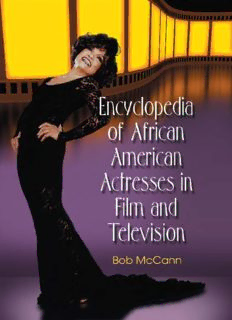
Encyclopedia of African American Actresses in Film and Television PDF
Preview Encyclopedia of African American Actresses in Film and Television
Encyclopedia of African American Actresses in Film and Television This page intentionally left blank Encyclopedia of African American Actresses in Film and Television B M C OB C ANN McFarland & Company, Inc., Publishers Jefferson, North Carolina, and London Publisher’s Note:Bob McCann died in 2009, shortly after completing the manuscript for this book. LIBRARYOFCONGRESSCATALOGUING-IN-PUBLICATIONDATA McCann, Bob, 1948– Encyclopedia of African American actresses in film and television / Bob McCann. p. cm. Includes bibliographical references and index. ISBN 978-0-7864-3790-0 illustrated case binding : 50# alkaline paper 1. African American actresses—Biography—Dictionaries. I. Title. PN1995.9.N4M345 2010 791.4302'8092396073—dc22 2009037436 British Library cataloguing data are available ©2010 Bob McCann. All rights reserved No part of this book may be reproduced or transmitted in any form or by any means, electronic or mechanical, including photocopying or recording, or by any information storage and retrieval system, without permission in writing from the publisher. Front cover: Eartha Kitt; background ©2010 Shutterstock. Manufactured in the United States of America McFarland & Company, Inc., Publishers Box 611, Jefferson, North Carolina 28640 www.mcfarlandpub.com For Martha Acknowledgments My thanks to Tom Lisanti of the New York Public Library Photo- graphic Services and Permissions, Katrina Groover, Mary F. Yearwood and the staff of the Schomburg Center for Research in Black Culture, Astor, Lenox and Tilden Foundations, Adam Robinson, Hattie Winston and Lark Voorhees for that killer head shot! vi Contents Acknowledgments vi Preface 1 AFRICAN AMERICAN ACTRESSES, A TO Z 3 Bibliography 375 Index 377 vii This page intentionally left blank Preface This book focuses on positive achieve- into the category of African American. ment. It is a celebration of talent, fortitude, However, many black actresses not born intelligence and beauty. It is not a sociolog- in America have had notable careers in ical treatise on the evils of racism or the pit- American films or on American TV, and falls of stereotyping—although it is abun- are American citizens or have dual citi- dantly clear that these problems have been zenships. This includes a number of and continue to be real. Although there are a British- and Canadian-born actresses. number of black female superstars in the Then there are the Caribbean-born ac- music business, once you get beyond Halle tresses who are or were American citizens Berry, the number of highly paid, star-level and who have done all or most of their black film actresses is low. This is clearly not acting in the U.S. Also included are for lack of talent. Race aside, however, the African-born actresses who are American era of the female cinema superstar of anyeth- citizens and who have primarily focused nic group has at least temporarily gone into on U.S. films or TV. A good example is eclipse. The career of a Bette Davis, a Joan Akosua Busia, born in Ghana, but who Crawford, or a Katharine Hepburn has no is an American citizen (the former wife contemporary equivalent (with the conspic- of director John Singleton), and who has uous sole exception of Meryl Streep). acted extensively in America, including a Given the broad topic of this encyclope- key role in The Color Purple. dia, there are a number of reasons why an ac- • A small but significant group of actresses tress was included (or excluded). Broad-based who, although born in America, spent inclusion criteria are: most of their professional careers in Europe (e.g., Josephine Baker, Olive • Black actresses who have broadened the Moorefield). These actresses are of course opportunities for other black actresses, or considered African American, although who have helped redefine the image of much of their work was not done in this black women on screen. country. • All award-winning or well-known black • New young actresses who appear to have actresses who have sustained film or tele- the potential for sustained careers—e.g., vision careers and those who have worked Keke Palmer, Yaya DaCosta, and many more prominently in theatre. others. I excluded some of the new gen- • Lesser-known or B-film actresses, espe- eration of actresses because there was a cially the actresses of the so-called blax- danger of an imbalance of contemporary ploitation era of the late 1960s and mid– entries, since there are so many more op- 1970s. portunities for black actresses these days. • Only those actresses who fit reasonably Inclusion and exclusion of new genera- 1
Description: